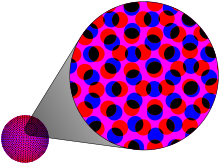
The Ben Day process is a printing and photoengraving technique for producing areas of gray or (with four-color printing) various colors by using fine patterns of ink on the paper. It was developed in 1879[1] by illustrator and printer Benjamin Henry Day Jr. (son of 19th-century publisher Benjamin Henry Day).[2] The process is commonly described in terms of Ben Day dots, but other shapes can be used, such as parallel lines or textures.[3]
Depending on the effect, color, or optical illusion needed, small colored dots are closely spaced, widely spaced, or overlapping.[4] Magenta dots, for example, are widely spaced to create pink, or an interleaved pattern of cyan and yellow dots might be used to produce a medium green. The technique has been widely used in color comic books, especially in the mid 20th century, to inexpensively create shading and secondary colors.[5][6][7]
The process differs from the halftone dots, which can vary continuously in size to produce gradations of shading or color, and are commonly produced from photographs. Ben Day dots are of equal size and distribution across a specific area, and are commonly applied to line art or graphic designs. To apply the dots, the artist would cut the appropriate shapes from transparent overlay sheets, which were available in a wide variety of dot size and distribution, to provide a range of tones to use. When photographically reproduced as a line cut for letterpress printing, the areas of Ben Day overlay provided the effect of tonal shading to the printing plate.[8][9]
Ben Day dots have been used deliberately, usually to evoke their use in color comics. They were a hallmark of American artist Roy Lichtenstein,[10] who enlarged and exaggerated them in many of his paintings and sculptures to evoke the printing technique used in the comic book illustrations he commonly copied. The animated trilogy Spider-Verse (2018–2024) uses a variety of visual styles, including illustrations with visible Ben Day dots.
YouTube Encyclopedic
-
1/3Views:5653 57218 488
-
Pop Art Painting & Benday Dots
-
Ben-Day Dots made with Marker
-
Ben-Day Dots defined - From Goodbye-Art Academy
Transcription
See also
- Dither
- Hatching (heraldry), the representation of color by monochrome lines.
- Letratone
- Polka dot
- Pointillism
References
- ^ Churchwell, Sarah (February 23, 2013). "Roy Lichtenstein: from heresy to visionary". The Guardian. London. Retrieved 2012-06-27.
- ^ G.H.E. Hawkins (1914) "Ben Day Effects", Newspaper Advertising, pp. 17–21, Advertisers Publishing Company, Chicago
- ^ Edmund F. Russ (Oct 1919) "The Ben Day Process", Western Advertising, Vol. 1 No. 9, pp. 5-&c, Ramsey Oppenheim Co., San Francisco
- ^ W. Livingston Larnard (1921) "How and When to Use Ben Day", The Printing Art Vol. 37, No.4, pp. 305–312 (See also: pp. 30, 216, 218, 347, 463)
- ^ "In Defense of Dots: The lost art of comic books".
- ^ "The Use and Abuse of Ben Day" (Jan 6, 1920) Business Digest and Investment Weekly, Vol. 25, No. 1. pp. 10–11, Arrow Publishing Corporation, NY
- ^ Success in Commercial Art (1920) Meyer Both College of Commercial Art
- ^ Gilbert P. Farrar (Sep 18, 1913) "Strong Displays by Use of 'Ben Day' Process", Printers' Ink, Vol. 84, No. 12, pp. 33–36, New York
- ^ Willard C. Brinton (1919). "Graphic Methods for Presenting Facts", Industrial Engineering and Engineering Digest, Vol. 14, No. 12, p. 466, New York
- ^ "Roy Lichtenstein Artist Profile | Andipa Gallery". Andipa Editions. Retrieved 2023-12-21.
